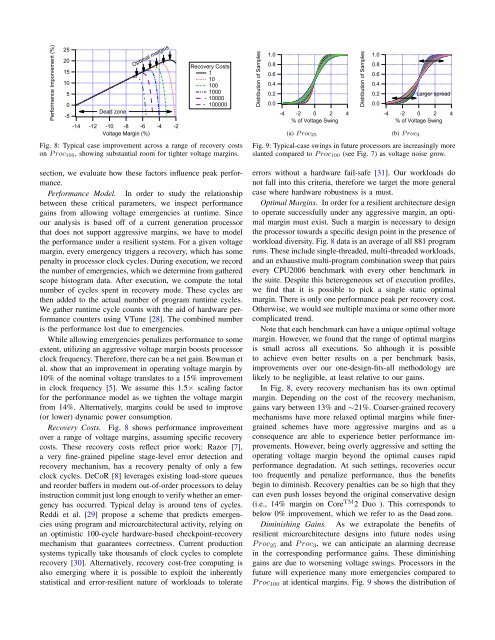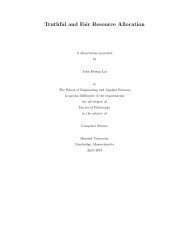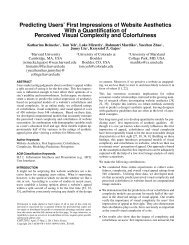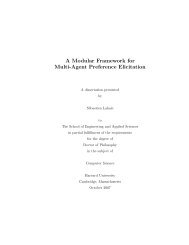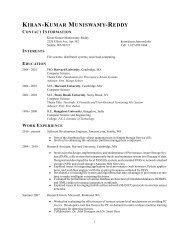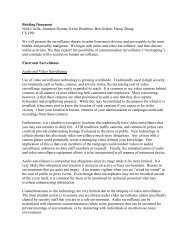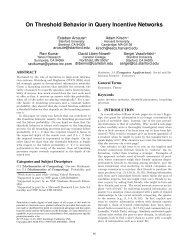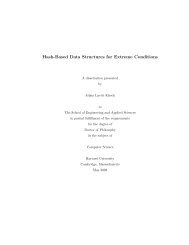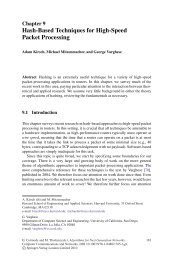Voltage Smoothing: Characterizing and ... - Harvard University
Voltage Smoothing: Characterizing and ... - Harvard University
Voltage Smoothing: Characterizing and ... - Harvard University
Create successful ePaper yourself
Turn your PDF publications into a flip-book with our unique Google optimized e-Paper software.
���������������������������<br />
��<br />
��<br />
��<br />
��<br />
�<br />
�<br />
��<br />
���������<br />
���������������<br />
��� ��� �� �� �� ��<br />
���<br />
������������������<br />
��������������<br />
�� ���<br />
��� ���<br />
����<br />
���<br />
�����<br />
���<br />
������<br />
���<br />
��� �������<br />
Fig. 8: Typical case improvement across a range of recovery costs<br />
on P roc100, showing substantial room for tighter voltage margins.<br />
section, we evaluate how these factors influence peak performance.<br />
Performance Model. In order to study the relationship<br />
between these critical parameters, we inspect performance<br />
gains from allowing voltage emergencies at runtime. Since<br />
our analysis is based off of a current generation processor<br />
that does not support aggressive margins, we have to model<br />
the performance under a resilient system. For a given voltage<br />
margin, every emergency triggers a recovery, which has some<br />
penalty in processor clock cycles. During execution, we record<br />
the number of emergencies, which we determine from gathered<br />
scope histogram data. After execution, we compute the total<br />
number of cycles spent in recovery mode. These cycles are<br />
then added to the actual number of program runtime cycles.<br />
We gather runtime cycle counts with the aid of hardware performance<br />
counters using VTune [28]. The combined number<br />
is the performance lost due to emergencies.<br />
While allowing emergencies penalizes performance to some<br />
extent, utilizing an aggressive voltage margin boosts processor<br />
clock frequency. Therefore, there can be a net gain. Bowman et<br />
al. show that an improvement in operating voltage margin by<br />
10% of the nominal voltage translates to a 15% improvement<br />
in clock frequency [5]. We assume this 1.5× scaling factor<br />
for the performance model as we tighten the voltage margin<br />
from 14%. Alternatively, margins could be used to improve<br />
(or lower) dynamic power consumption.<br />
Recovery Costs. Fig. 8 shows performance improvement<br />
over a range of voltage margins, assuming specific recovery<br />
costs. These recovery costs reflect prior work: Razor [7],<br />
a very fine-grained pipeline stage-level error detection <strong>and</strong><br />
recovery mechanism, has a recovery penalty of only a few<br />
clock cycles. DeCoR [8] leverages existing load-store queues<br />
<strong>and</strong> reorder buffers in modern out-of-order processors to delay<br />
instruction commit just long enough to verify whether an emergency<br />
has occurred. Typical delay is around tens of cycles.<br />
Reddi et al. [29] propose a scheme that predicts emergencies<br />
using program <strong>and</strong> microarchitectural activity, relying on<br />
an optimistic 100-cycle hardware-based checkpoint-recovery<br />
mechanism that guarantees correctness. Current production<br />
systems typically take thous<strong>and</strong>s of clock cycles to complete<br />
recovery [30]. Alternatively, recovery cost-free computing is<br />
also emerging where it is possible to exploit the inherently<br />
statistical <strong>and</strong> error-resilient nature of workloads to tolerate<br />
�����������������������<br />
���<br />
���<br />
���<br />
���<br />
���<br />
���<br />
�� � � �<br />
��<br />
������������������<br />
(a) P roc25<br />
�����������������������<br />
���<br />
���<br />
���<br />
���<br />
���<br />
���<br />
�������������<br />
�� � � �<br />
��<br />
������������������<br />
(b) P roc3<br />
Fig. 9: Typical-case swings in future processors are increasingly more<br />
slanted compared to P roc100 (see Fig. 7) as voltage noise grow.<br />
errors without a hardware fail-safe [31]. Our workloads do<br />
not fall into this criteria, therefore we target the more general<br />
case where hardware robustness is a must.<br />
Optimal Margins. In order for a resilient architecture design<br />
to operate successfully under any aggressive margin, an optimal<br />
margin must exist. Such a margin is necessary to design<br />
the processor towards a specific design point in the presence of<br />
workload diversity. Fig. 8 data is an average of all 881 program<br />
runs. These include single-threaded, multi-threaded workloads,<br />
<strong>and</strong> an exhaustive multi-program combination sweep that pairs<br />
every CPU2006 benchmark with every other benchmark in<br />
the suite. Despite this heterogeneous set of execution profiles,<br />
we find that it is possible to pick a single static optimal<br />
margin. There is only one performance peak per recovery cost.<br />
Otherwise, we would see multiple maxima or some other more<br />
complicated trend.<br />
Note that each benchmark can have a unique optimal voltage<br />
margin. However, we found that the range of optimal margins<br />
is small across all executions. So although it is possible<br />
to achieve even better results on a per benchmark basis,<br />
improvements over our one-design-fits-all methodology are<br />
likely to be negligible, at least relative to our gains.<br />
In Fig. 8, every recovery mechanism has its own optimal<br />
margin. Depending on the cost of the recovery mechanism,<br />
gains vary between 13% <strong>and</strong> ∼21%. Coarser-grained recovery<br />
mechanisms have more relaxed optimal margins while finergrained<br />
schemes have more aggressive margins <strong>and</strong> as a<br />
consequence are able to experience better performance improvements.<br />
However, being overly aggressive <strong>and</strong> setting the<br />
operating voltage margin beyond the optimal causes rapid<br />
performance degradation. At such settings, recoveries occur<br />
too frequently <strong>and</strong> penalize performance, thus the benefits<br />
begin to diminish. Recovery penalties can be so high that they<br />
can even push losses beyond the original conservative design<br />
(i.e., 14% margin on Core TM 2 Duo ). This corresponds to<br />
below 0% improvement, which we refer to as the Dead zone.<br />
Diminishing Gains. As we extrapolate the benefits of<br />
resilient microarchitecture designs into future nodes using<br />
P roc25 <strong>and</strong> P roc3, we can anticipate an alarming decrease<br />
in the corresponding performance gains. These diminishing<br />
gains are due to worsening voltage swings. Processors in the<br />
future will experience many more emergencies compared to<br />
P roc100 at identical margins. Fig. 9 shows the distribution of


